
Posted on 04/02/2015 4:13:46 AM PDT by Homer_J_Simpson

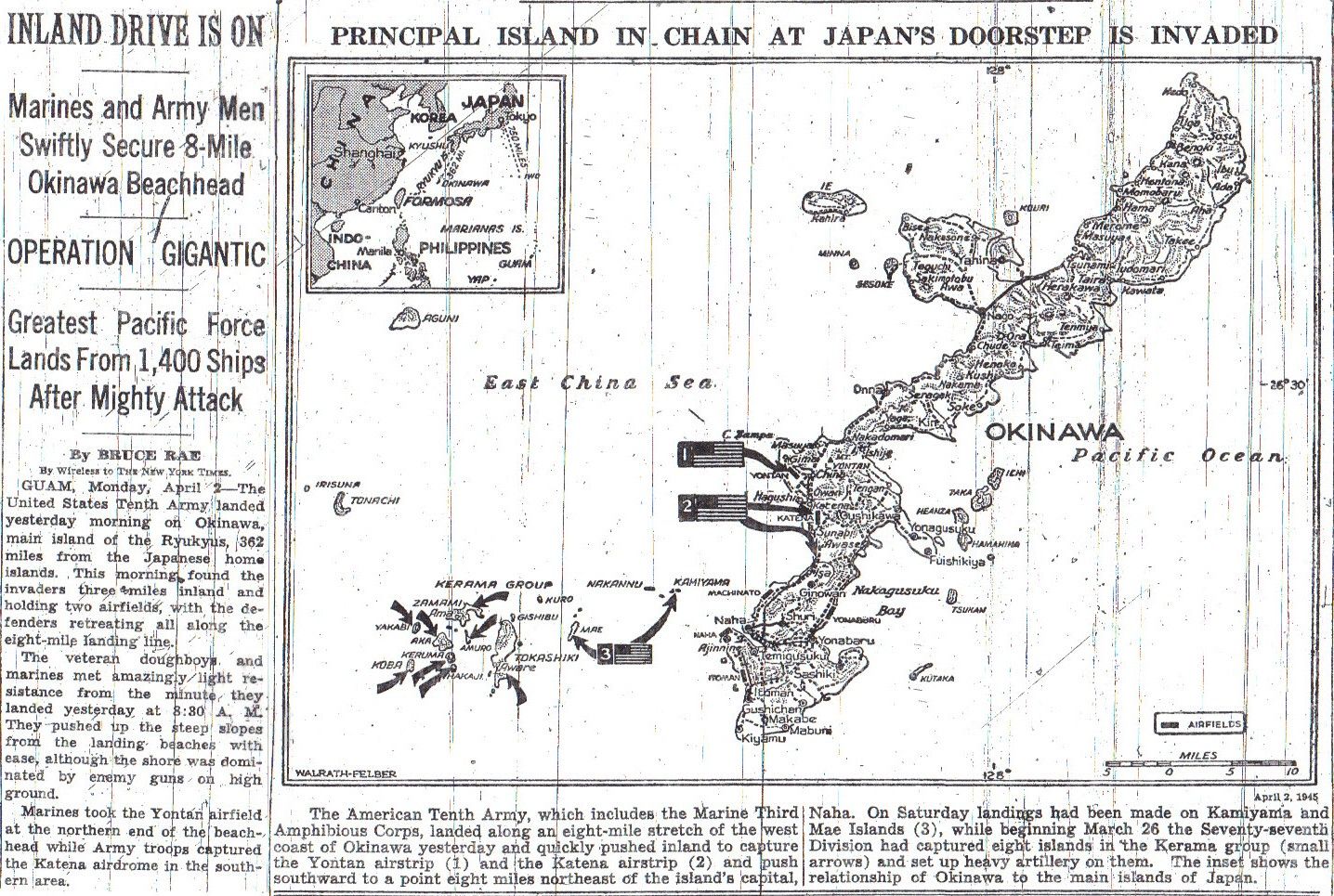
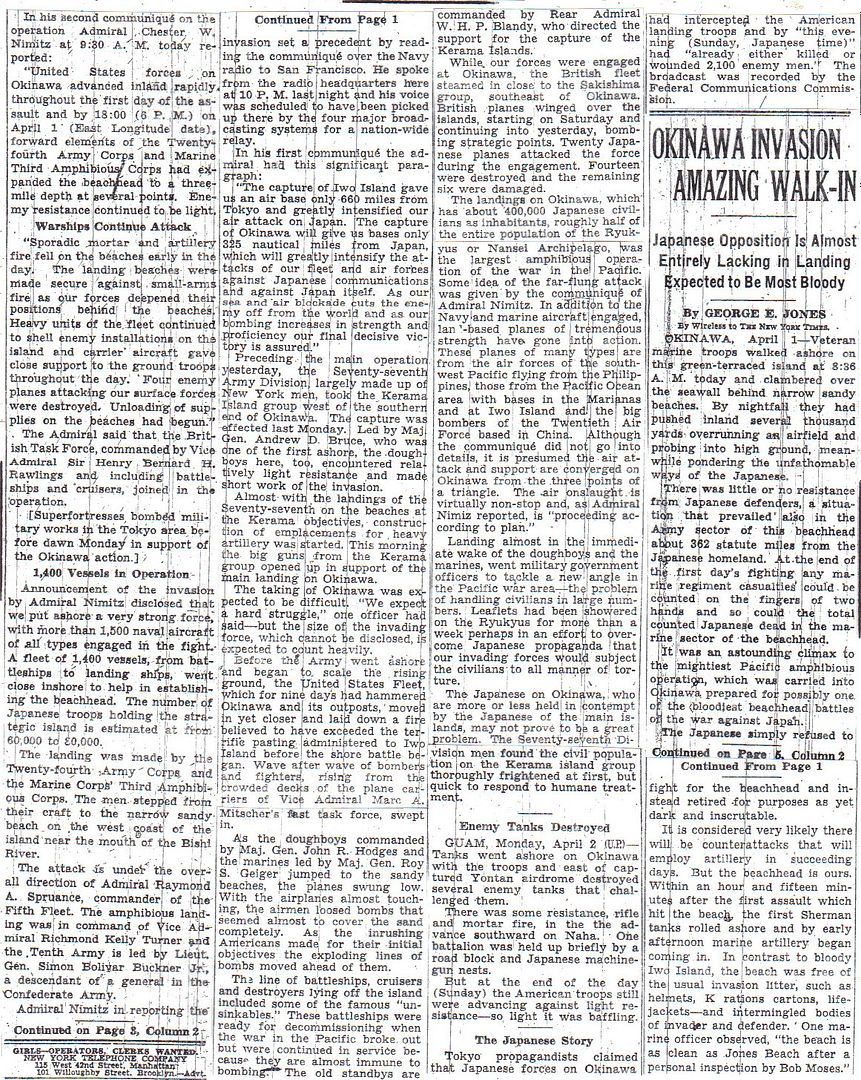
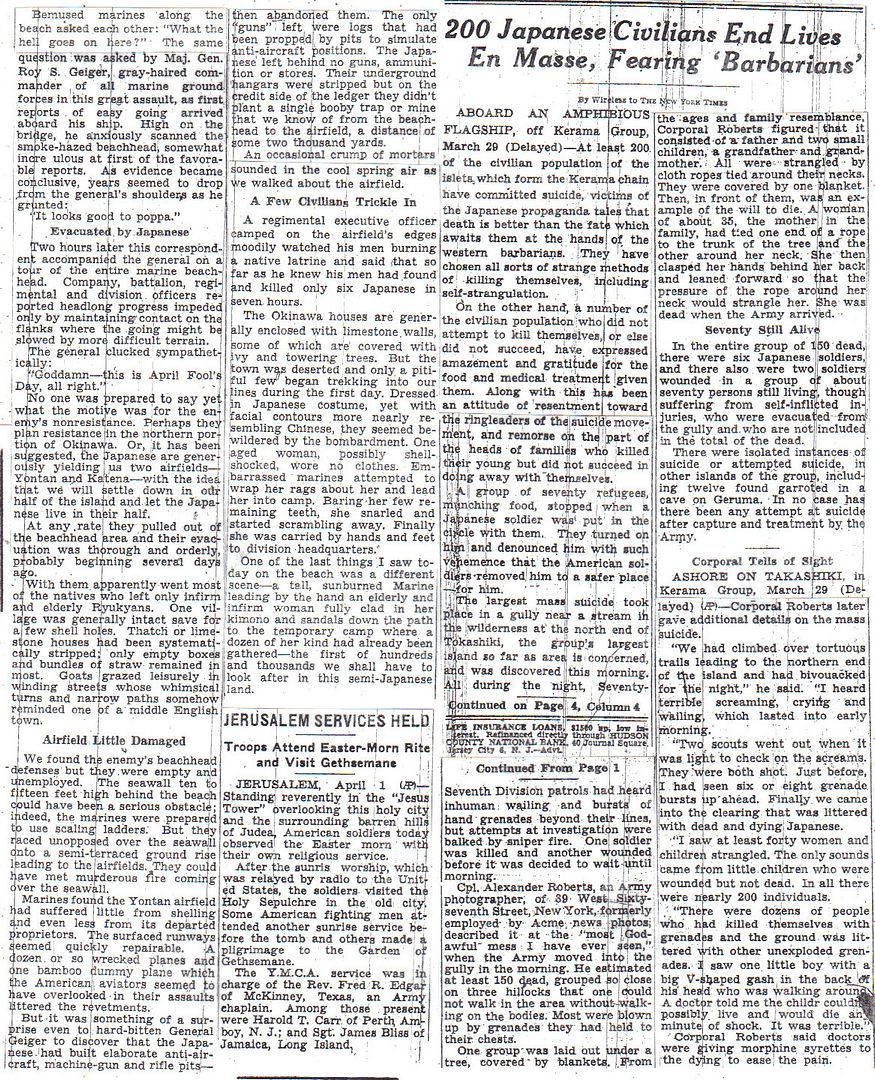
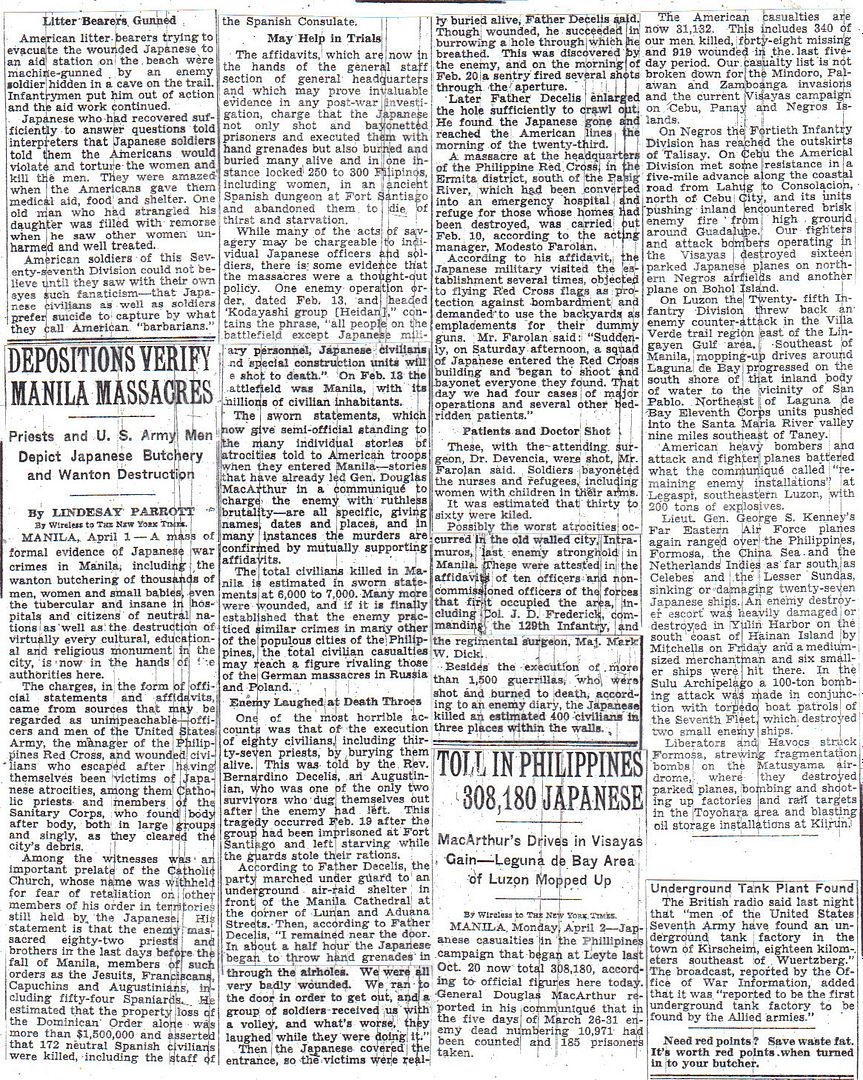
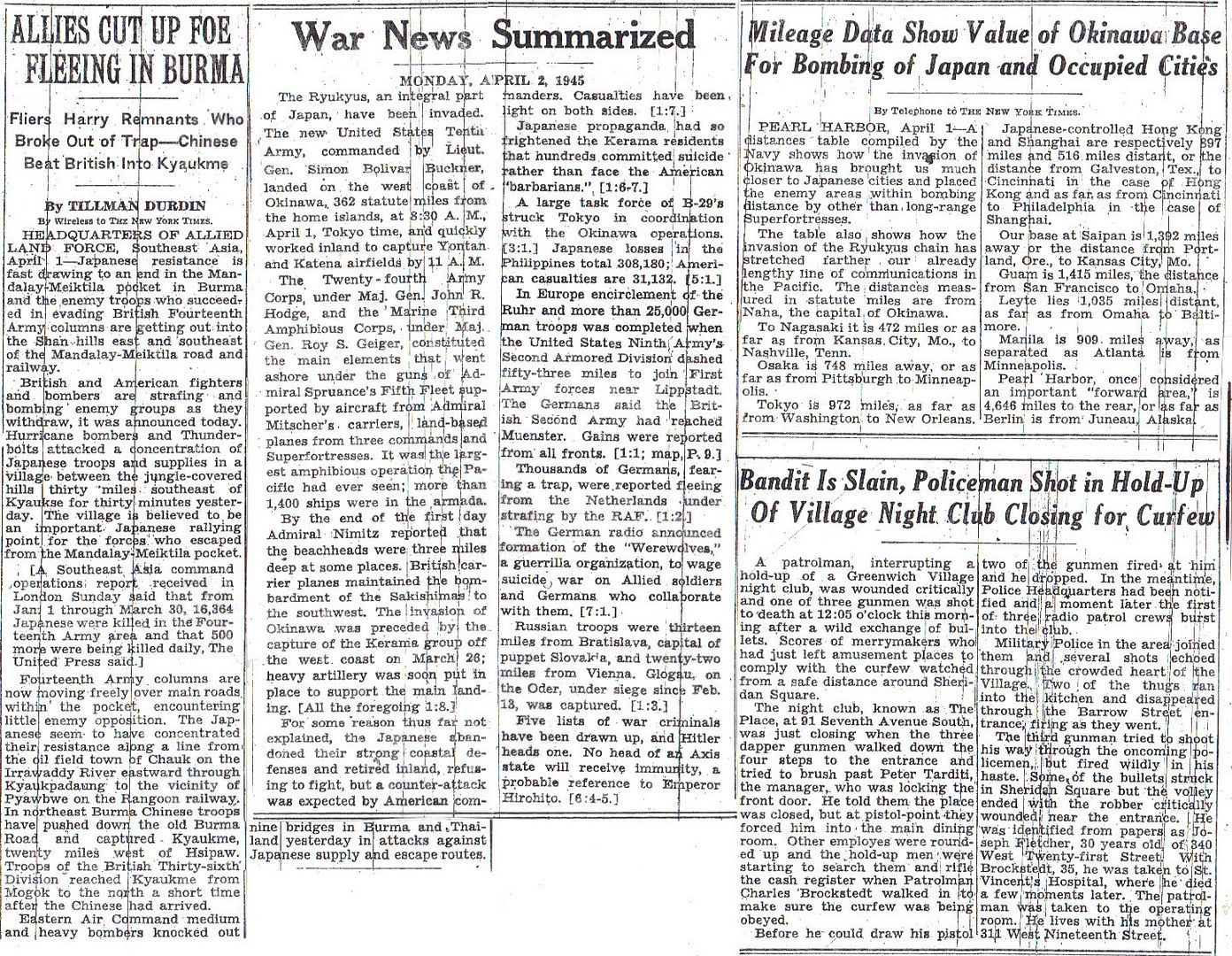
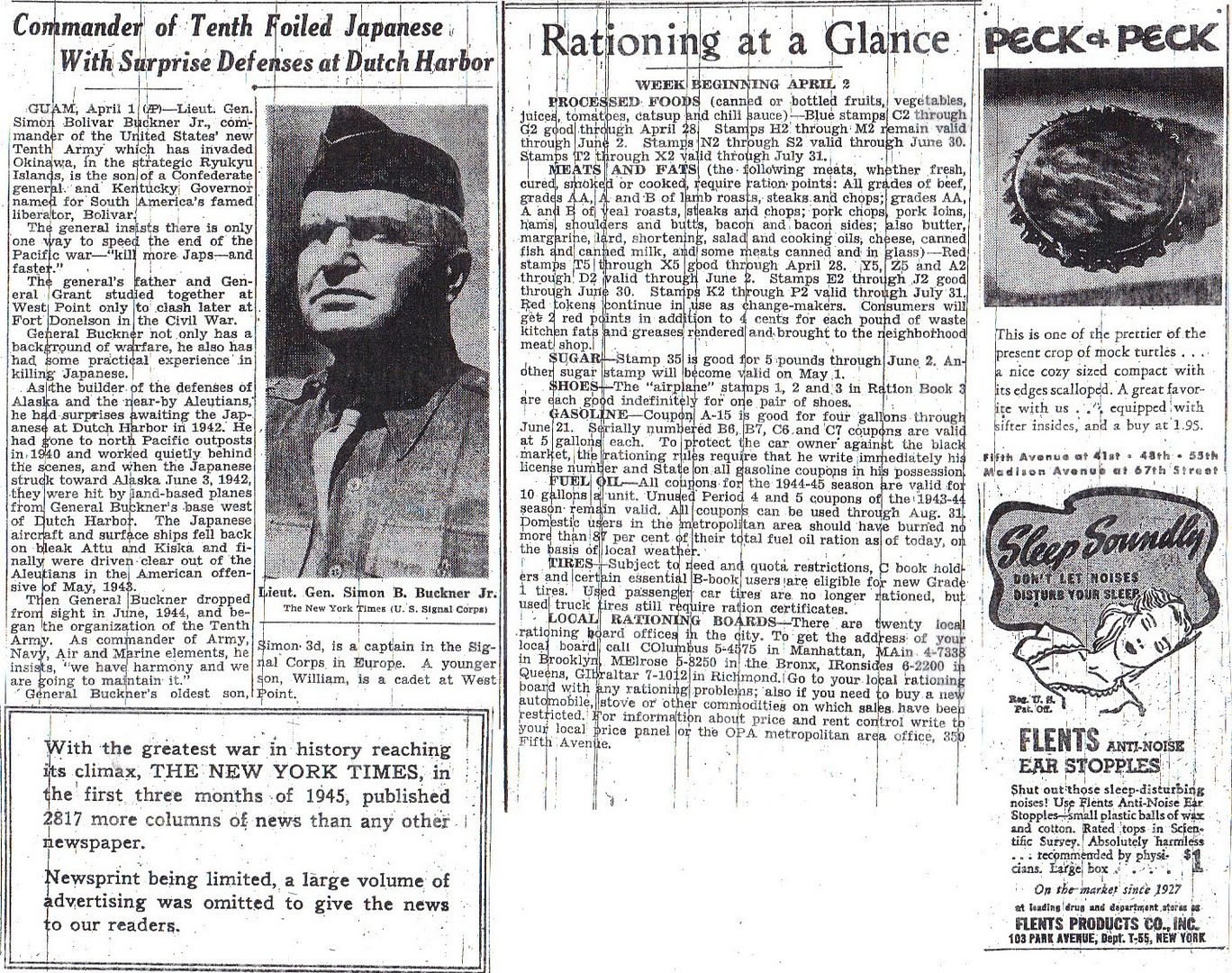

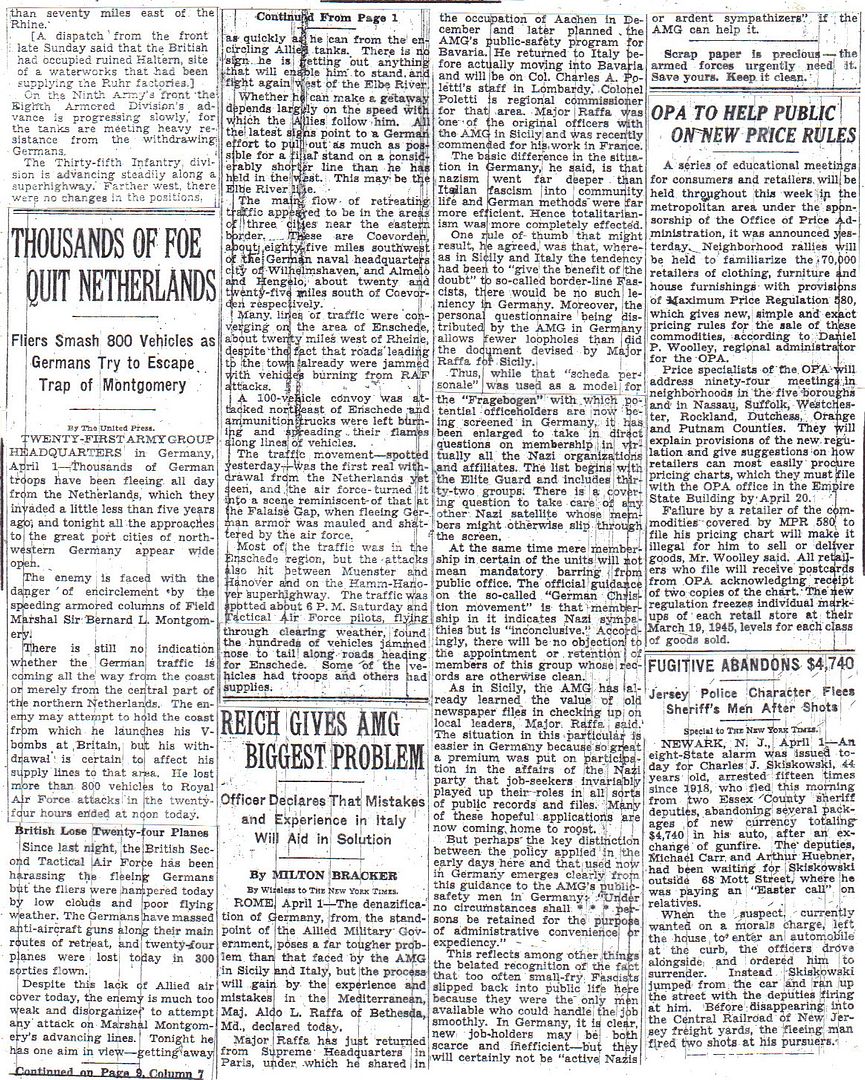

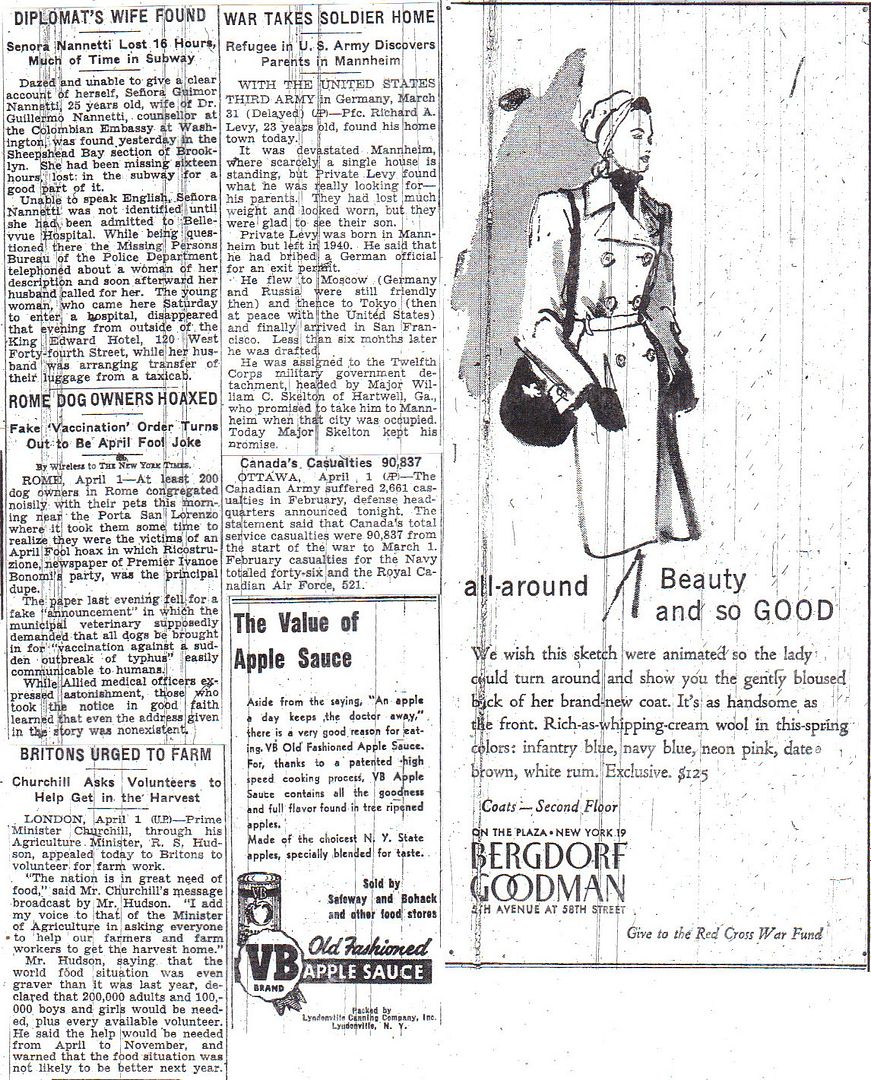
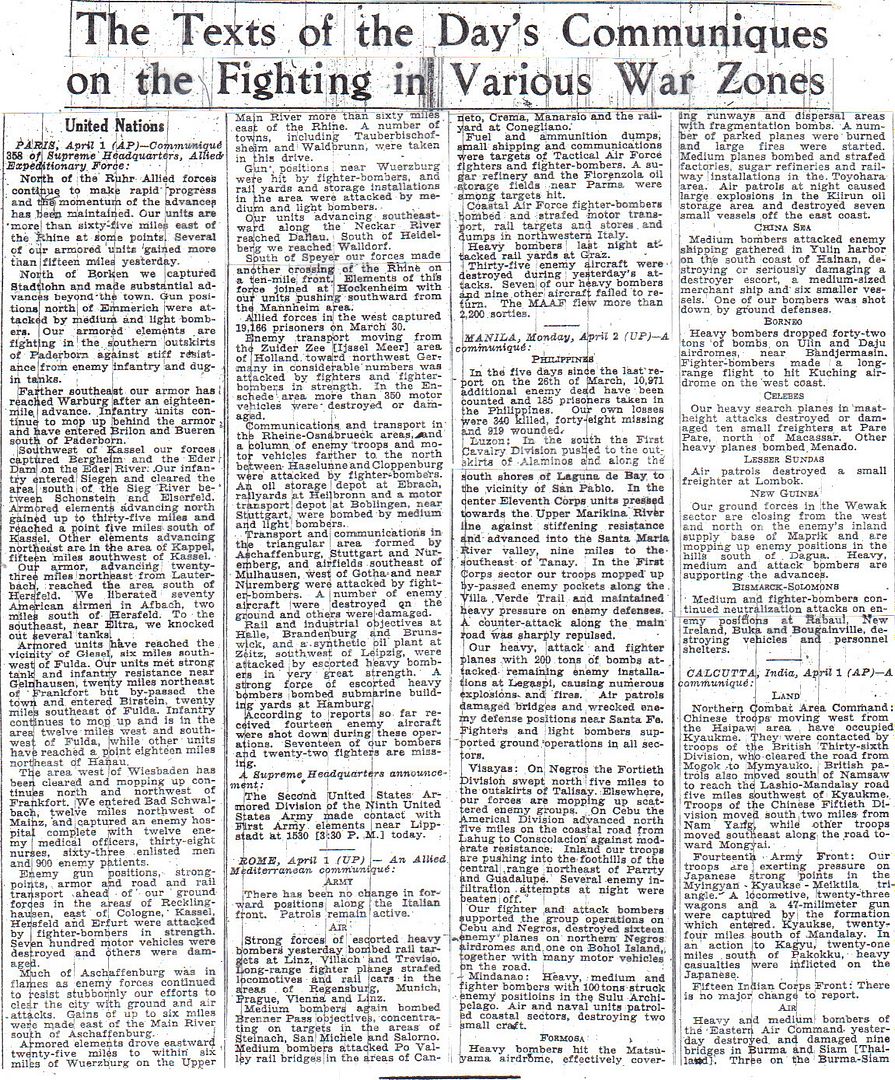
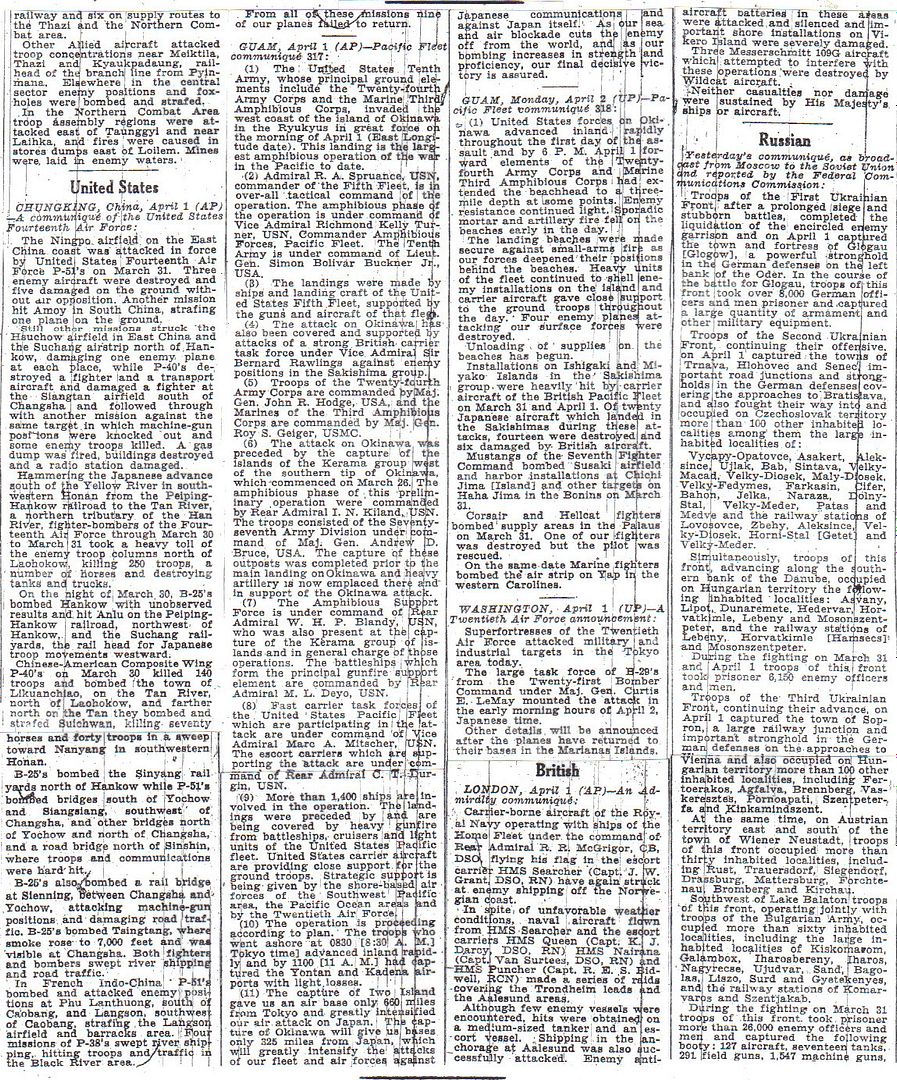

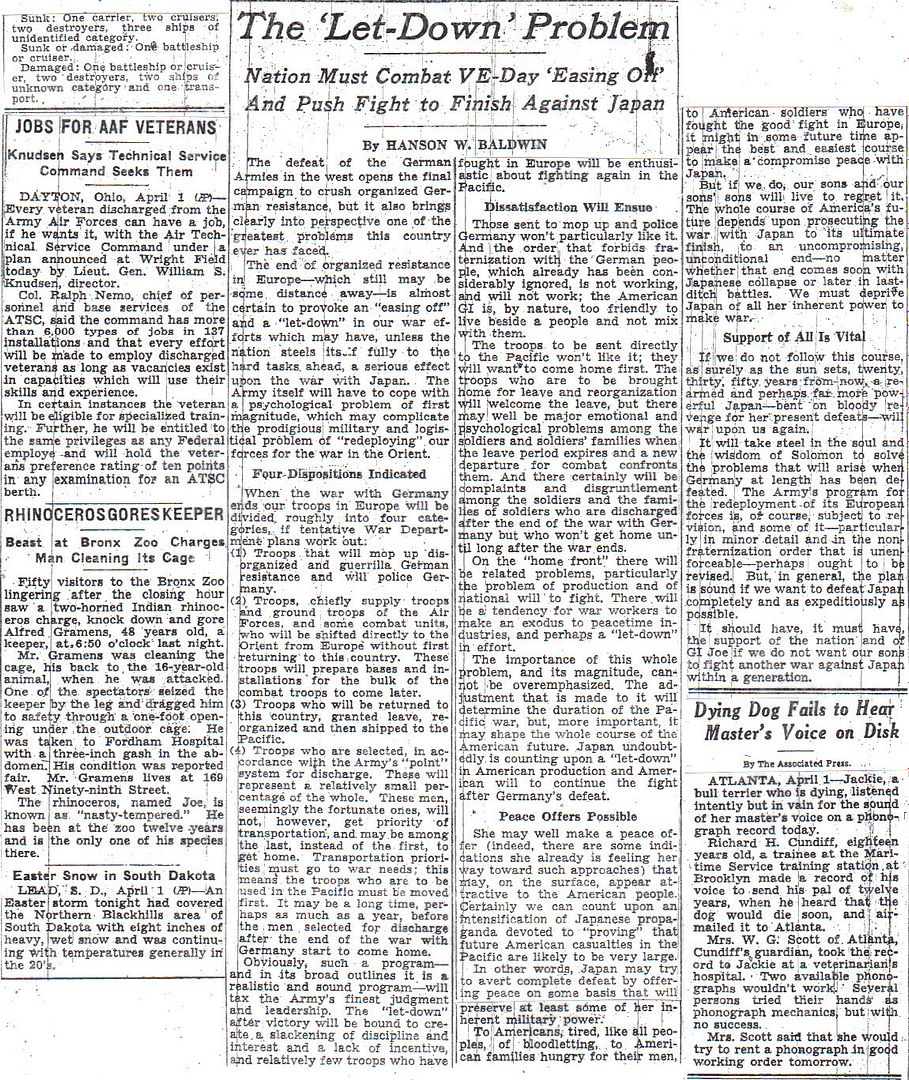
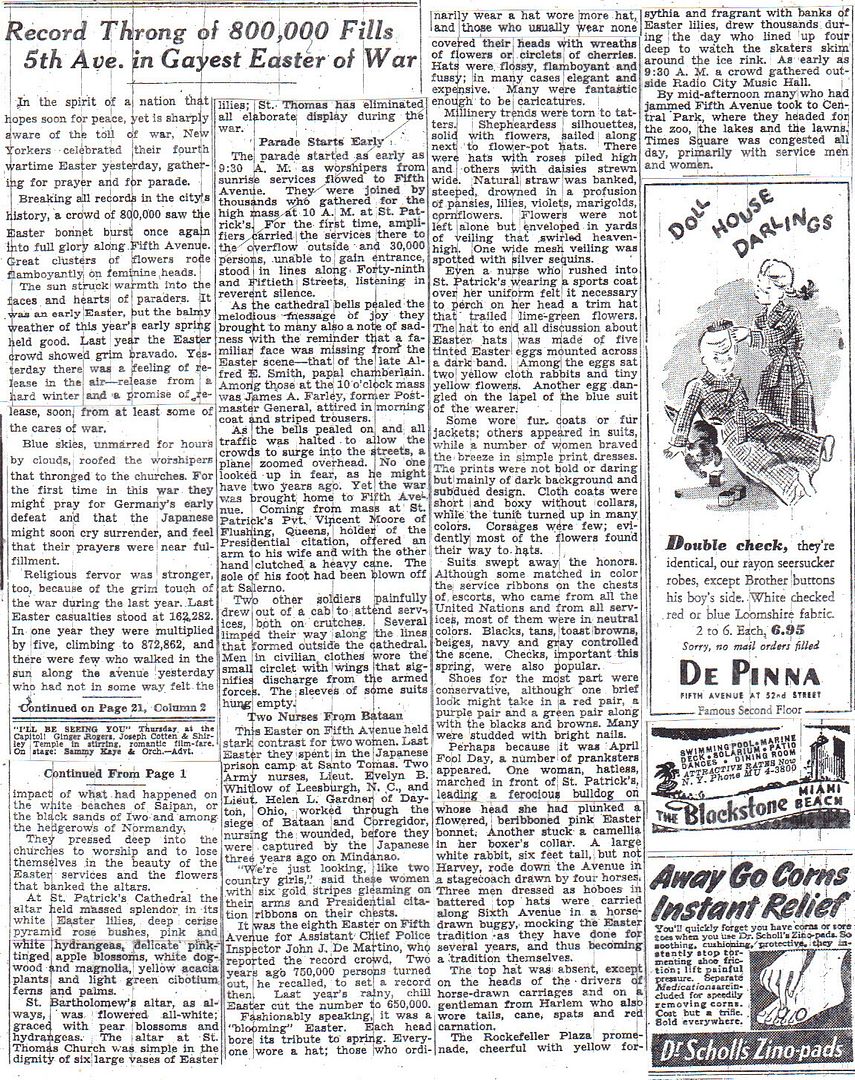
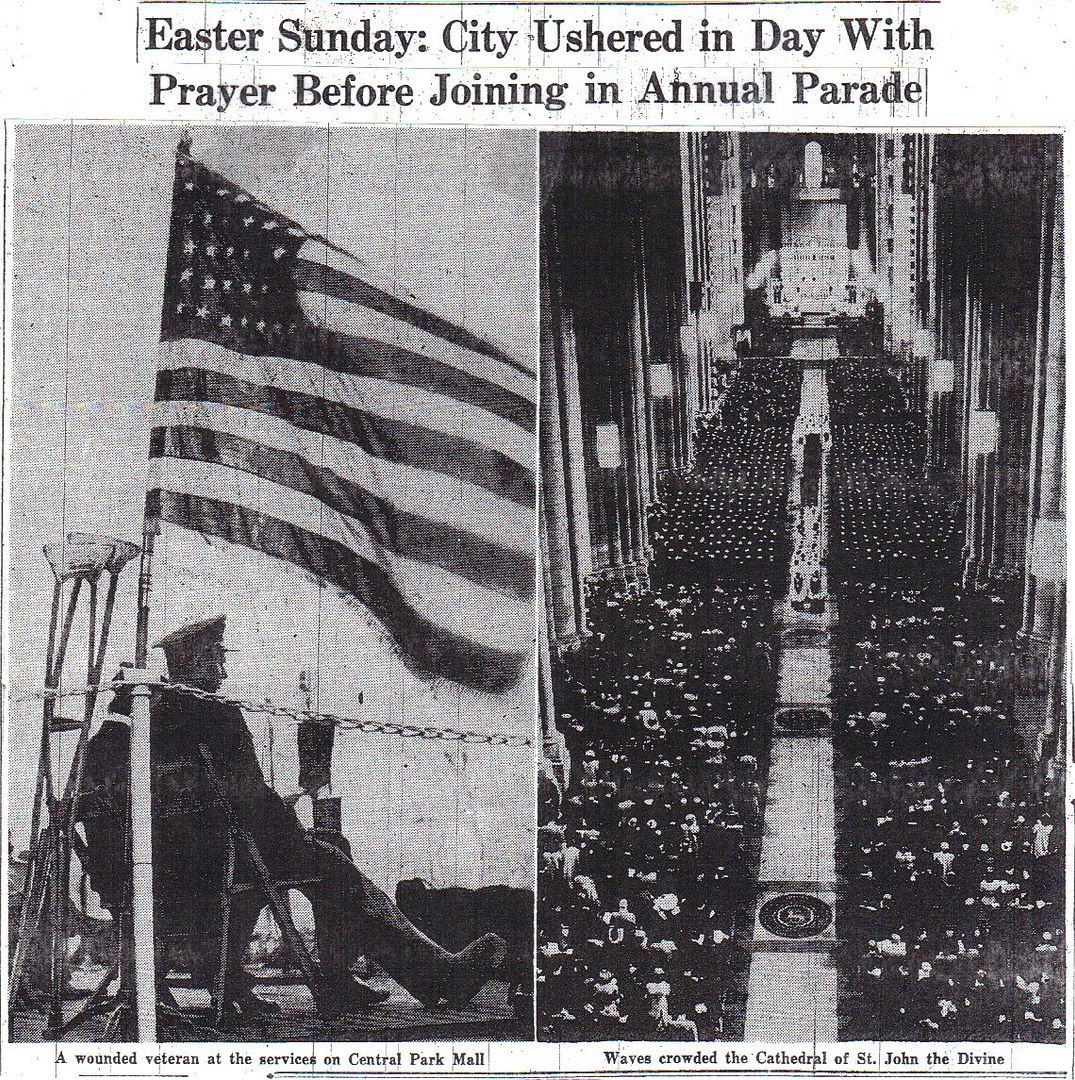
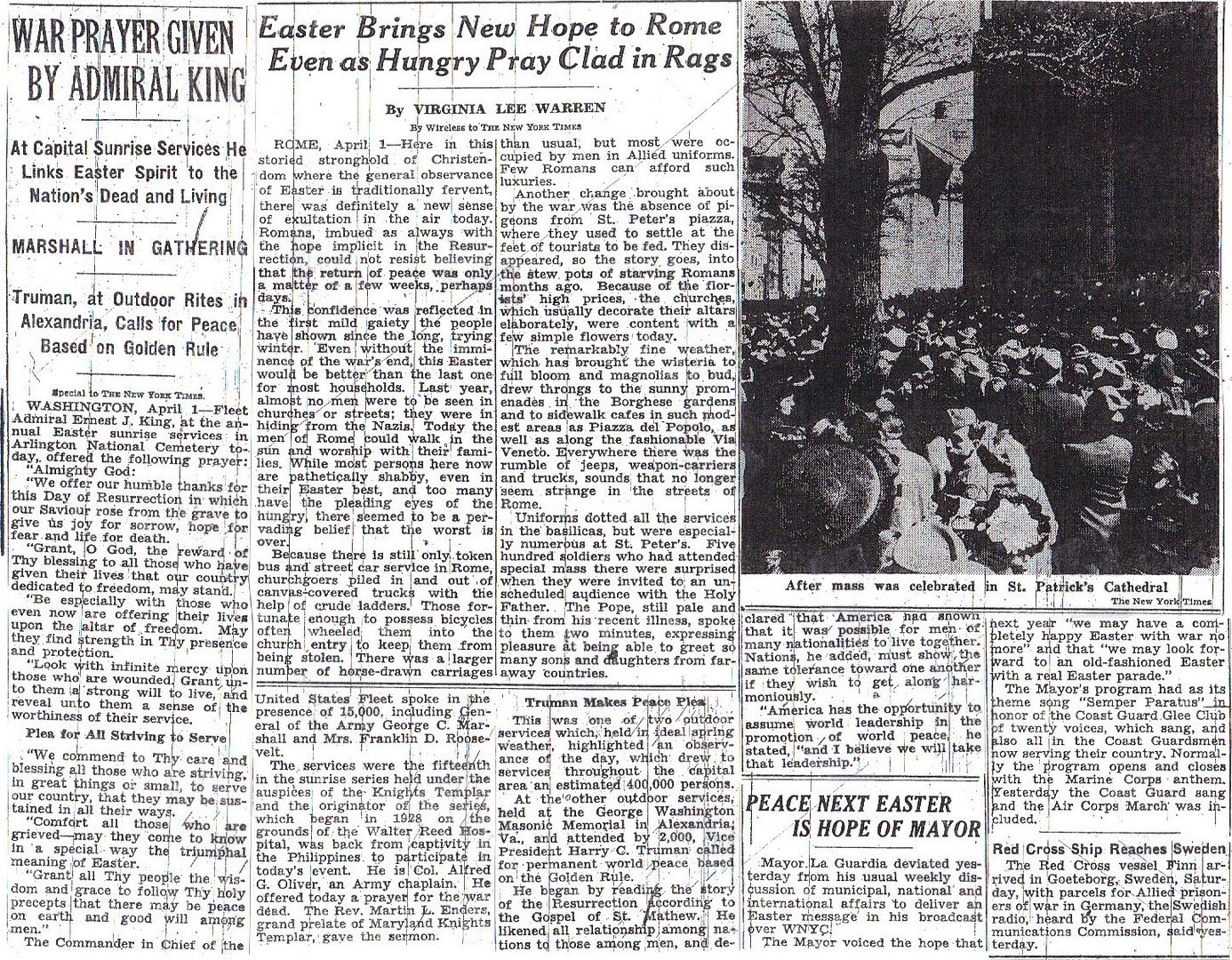
Inland Drive is On (Rae) – 2-3
Okinawa Invasion Amazing Walk-In (Jones) – 3-4
200 Japanese Civilians End Lives En Masse, Fearing ‘Barbarians’ – 4-5
Depositions Verify Manila Massacres (Parrott) – 5
Toll in Philippines 308,180 Japanese – 5
Allies Cut Up Foe Fleeing in Burma (Durdin) – 6 War News Summarized – 6
Mileage Data Show Value of Okinawa Base For Bombing of Japan and Occupied Cities – 6
Bandit is Slain, Policeman Shot in Hold-Up Of Village Night Club Closing for Curfew – 6
Commander of Tenth Foiled Japanese With surprise Defenses at Dutch Harbor – 7
Rationing at a Glance – 7
Allies Trap 30,000 (Middleton) – 8-9
Thousands of Foe Quit Netherlands – 9
Reich Gives AMG Biggest Problem (Bracker) – 9
Vienna Drive Gains – 10
The Texts of the Day’s Communiques on the Fighting in Various War Zones – 12-15
The ‘Let-Down’ Problem (by Hanson W. Baldwin) – 15
Record Throng of 800,000 Fills 5th Ave. in Gayest Easter of War – 16
Easter Sunday: City Ushered in Day With Prayer Before Joining in Annual Parade (photos) – 17-18
War Prayer Given by Admiral King – 18
Easter Brings New Hope to Rome Even as Hungry Pray Clad in Rags (by Virginia Lee Warren) – 18
http://www.etherit.co.uk/month/3/02.htm
April 2nd, 1945 (MONDAY)
GERMANY: British 2nd Army advances north of Ruhr. Münster is taken. The Canadian 1st Army advances N. and E. between Nijmegan and Emmerith.
Cpl Edward Thomas Chapman (b.1920), Monmouthshire Regt., forced back to Germans with a Bren gun, and later halted an attack. He was wounded trying to rescue his officer. (Victoria Cross)
Ruhr: General Kurt Student was forced to postpone his planned counter-attack against the US Ninth Army in the Ruhr today because he has no fuel for his tanks. The shortage of fuel caused by Allied air attacks on synthetic fuel plants and the Red Army’s occupation of the Romanian and Hungarian oil fields has crippled Germany’s forces. The occupation by the Russians of Nagykanisza, the heart of the Hungarian oilfields, today shuts off the last tap.
Weather prevents operations by the 9th Bombardment Division and XXIX Tactical Air Command (Provisional). In Germany, the IX and XIX Tactical Air Commands fly patrols and armed reconnaissance over wide expanses of the country claiming 17 airplanes downed and the IX Tactical Air Command supports the US 9th Armored Division at the Diemel River bridgehead near Warburg.
DENMARK: The Eighth Air Force flies 2 missions. Mission 922: 447 B-17s, 261 B-24s and 572 P-47s and P-51s are dispatched against 6 airfields but are recalled because of bad weather in the target area; a B-17 and a P-47 are lost.
Mission 923: During the night of 2/3 April, 9 B-24s drop leaflets in the Netherlands, France and Germany without loss and 10 B-24s fly CARPETBAGGER missions to Denmark without loss.
AUSTRIA: Almost 600 Fifteenth Air Force B-24s and B-17s, with fighter escorts, bomb communications targets including the marshalling yards at Graz, Sankt Polten, and Krems, and a railroad bridge on the Sulm River; 38 P-38s dive-bomb a railroad bridge at Wildon; 71 P-38s and 55 P-51s strafe Vienna-Munich, Germany and Wiener-Neustadt-Maribor, Yugoslavia rail traffic; others carry out photo and weather reconnaissance and reconnaissance escort flights.
ITALY: Cpl Thomas Peck Hunter (b.1923), Royal Marines, charged 200 yards to draw fire away from his men. He forced three gun crews to surrender or flee, pressing on until he was killed. (Victoria Cross)
Major General Benjamin W Chidlaw takes command of the Twelfth Air Force and will shortly take over command of the Mediterranean Allied Tactical Air Force (MATAF) also.
Twelfth Air Force A-20s and A-26 Invaders continue intruder missions during the night of 1/2 April concentrating on Po River crossings and other Po Valley communications targets; B-25s bomb railroad bridges at Fornovo di Taro, Drauburg, San Michele all’ Adige, Matrei am Brenner, Steinach, and Colle Isarco, and a railroad fill at Vo Sinistro; fighters and fighter-bombers again hit communications in the Po Valley but divert sizeable effort to attacks on methane plants in the central Po area; the P-47s are attacked by about 40 fighters during the day, 13 are claimed destroyed.
BORNEO: Far East Air Force B-24s hit the Sandakan shipyards and Tawau Airfield.
BURMA: Bad weather cancels all Tenth Air Force offensive missions; air supply missions continue with 469 sorties being flown to forward areas.
CHINA: 25 Fourteenth Air Force B-25s attack trucks, tanks, rivercraft, and targets of opportunity at Sichuan, Neihsiang, Sinyang, Mingkiang, Siangtan, Kweiping, Nanning, and Hengshan; 4 B-24s bomb the Kowloon Docks in Hong Kong and hit shipping at Bakli and Samah Bays on Hainan Island; 32 P-51s pound airfields in the Shanghai area; 140+ other fighter-bombers attack numerous targets scattered throughout southern and eastern China, including troops, trucks, horses, river shipping, bridges, gun positions, airfields, rail traffic, and town areas.
The Fifth Air Force dispatches 37 Fifth B-24s, escorted by fighters, to bomb the harbour at Hong Kong.
FRENCH INDOCHINA: 28 Tenth Air Force B-25s knock out a bridge southeast of That Khe, bomb the town area of Vinh, damage the bridge approaches at Kep, hit shipping and other targets of opportunity along the coast of the Gulf of Tonkin, and bomb the town area of Luc Nam.
Off the coast, the USN submarine USS Hardhead (SS-365) lays mines off Cape Camau.
PACIFIC OCEAN: RN and USN submarines sink four Japanese ships.
COMMONWEALTH OF THE PHILIPPINES: The US 163rd Regiment lands at Tawitawi in the Sulu Archipelago.
This was the 163d Regimental Combat Team (Reinforced) which landed on Sanga Sanga Island (5.04N,119.46E) in the Sulu Archipelago, Philippine Islands. Filipino guerrillas had cleared the island in March so the 163d did not encounter any opposition. Three USN destroyers supported the landing.
US Army troops capture La Carolta and Talisay Airfields on Negros Island.
On Luzon, Far East Air Force B-25s and fighter-bombers attack the Bamban bridges, the Balete Pass-Baguio area and Penablanca. Japanese troops at Cebu City on Cebu Island and on Negros Island are bombed by B-25s and fighter bombers. B-24s bomb the Sarangani Bay area on Mindanao Island and also bomb Bongao Island.
Off Okinawa, 4 US transports are damaged by Kamikaze forces.
The four ships were the attack transports USS Henrico (APA-45) and USS Goodhue (APA-107), and the attack cargo ships USS Achernar (AKA-53 and USS Tyrrell (AKA-80). Two other ships damaged by kamikazes are the high-speed transport USS Dickerson (APD-21) and infantry landing craft (gunboat) USS LCI(G)-568. The attack transport USS Chilton (APA-38) is damaged by a near-miss of a kamikaze and attack cargo ship USS Lacerta (AKA-29) is damaged by friendly fire.
Other ships damaged off Okinawa today include:
The destroyer USS Franks (DD-554) which collides with the battleship USS New Jersey (BB-62).
The destroyer USS Borie (DD-704) which collides with the aircraft carrier USS Essex (CV-9).
The destroyer escort USS Foreman (DE-633) which is struck by a bomb.
JAPAN: 3 missions are flown by the XXI Bomber Command:
- Mission 51: 115 B-29s bomb the Nakajima aircraft factory at Tokyo; they claim 1-1-0 Japanese aircraft; 6 B-29s are lost.
- Mission 52: During the night of 1/2 April, 6 B-29s mine the harbour at Kure on Honshu Island between 0000 and 0400 hours local without loss.
- Mission 53: During the night of 2/3 April, 9 B-29s mine the harbour at Hiroshima on Honshu without loss.
In the North Pacific, 12 Guam-based Seventh Air Force B-24s bomb Marcus Island.
Off Okinawa, aircraft of Task Group 58.4 carriers sink three Japanese ships near Amami-Oshima.
Ryuji Nagataka. “I Was A Kamikaze”
Training
“In theory, our training would be completed in thirty days. However, delays due to shortages of fuel, and to American raids, meant it could last as long as two months. We were therefore given priority [for fuel], to the detriment of other pilots....
“There is a tendency to think that suicide attacks were simply a matter of crashing blindly and heedlessly into the target. As I have already said, it was not as easy as that.
“Taking off, for example, required the utmost caution. With a bomb weighing over 500 pounds, the Ki-43 [Nakajima Hayabusa] would stall if pulled up off the ground in the usual way, so our first day was devoted to take-off drill.
“A log weighing about 200 pounds was fastened under the planes in lieu of a bomb. Needing a longer runway than the Ki-45 [Kawasaki Toryu], we had to bring the nose up right at the end of the runway, at the level of the trees that bordered the field....”
U.S.A.: In the Aleutians, an Eleventh Air Force B-24 on weather reconnaissance returns early due to mechanical trouble; another B-24 investigates radar jamming on Kresta Point on Attu Island.
My dad was there, manning an antiaircraft gun emplacement at the base of the #3 turret of the Maryland, when a kamikaze hit the top of that turret.
He fraternized, and apparently did so with enthusiasm. He liked the people, the food, the scenery, the dancing… and I would imagine that not being shot at for the first time since June of 1944 colored his attitude. As a boy, B had been taught a bit of German by his mother and an aunt, so he communicated with Germans more easily than with the Francophones of France and Belgium. Both of my ETO uncles came back with good memories of Britain (except for the food), and post-surrender Germany.
Mr. niteowl77
I chuckled at the story about the “gay” parade turnout. My wife suggested that the NY Times might just use the term “niggardly” next. (Meaning frugal.)
We have certainly come a long way since those days. When the newspapers and the average Joe was literate.
I took notice of the little card thing on Page 7, stating that the NYT omitted most ads to devote more room for war coverage.
Think they’d do that today?
My Asian History professor back in college days insisted on referring to the islands as the “Rye-you Kye-yous. No matter how hard he tried, he couldn’t say Ree-yuke keyous...
A colleague in a graduate seminar back in the 1970's gave a presentation in which he referred to Mao Tse-tung as "Mayo" and Lin Piao as "Lin Pie-you." Otherwise, his presentation was excellent.
When I was going to college 40 years ago, I worked alongside an old man named Gordon, who was one of the infantrymen in the Okinawa campaign. He didn't talk about it much, but one day, after he had learned that my father had been on Guam in WWII but had gone to Japan with the family (including me) in the late 60s to work at Yokosuka during Vietnam, he decided to give me a set of letters he had received in the 1930s from a Japanese pen pal he had corresponded with when he was a teenager, but had lost contact with after Pearl Harbor of course.
Gordon never understood how the Japanese could like the Americans before the war, hate us so much during the war, and then go back to liking us and becoming allies after the war. Even then in my youth, I understood that the average Japanese never hated us in the first place, but would do what he was told was his duty for his country, as misguided as that was during the war.
The map looks a whole lot different now...
[April 2, 1945], HQ Twelfth Army Group situation map.
http://www.loc.gov/resource/g5701s.ict21302/
It’s lookin’ like we’re still gonna need to nuke Japan if they don’t surrender.
The Death Marches: The Final Phase of Nazi Genocide
At least the left room at the bottom of page 11 for an ad about the “value of apple sauce”.
Disclaimer: Opinions posted on Free Republic are those of the individual posters and do not necessarily represent the opinion of Free Republic or its management. All materials posted herein are protected by copyright law and the exemption for fair use of copyrighted works.